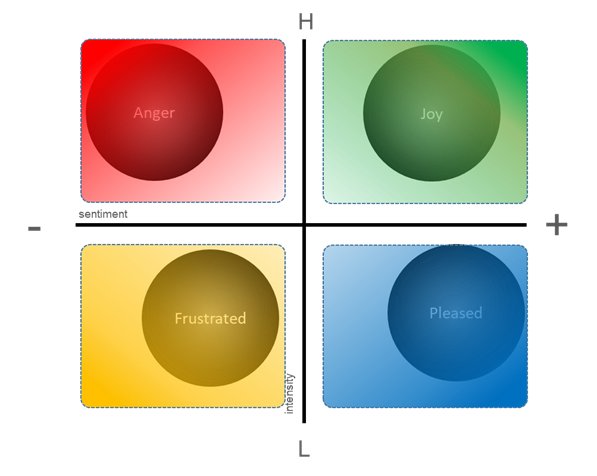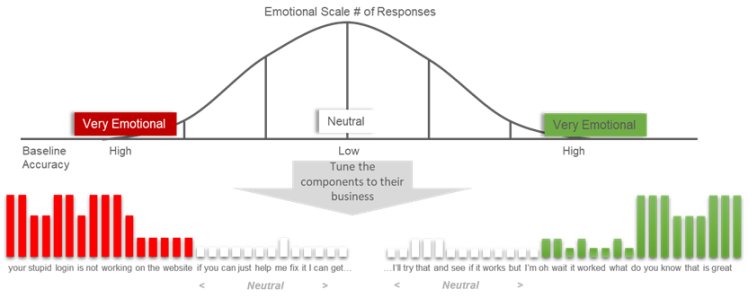How much AI is ‘real’ in CallMiner? All of it.
The question should be, “does one company do that better or more powerfully than the competition?” For CallMiner, our solution, with a logical blend o...
CallMiner Outreach is here! |Learn about the future of CX

Solutions
Products
Customers
Solutions
Products
Customers
Resources
Company
Detecting emotions is hard. It is hard for machines because it is hard for humans. This is simply true, and don’t let any amount of marketing or hype sway you. Will we in the artificial intelligence (AI) world figure this out? Eventually yes, but as inconvenient as it may be for marketers of SaaS companies, not yet.
So why is it so hard, and why do we believe the CallMiner platform is one of the leaders in the space? Let’s take a look.
As a basic working definition, emotions are the combination of sentiment and intensity. If we think of sentiment as the number of stars we give in a review on a website, we are pretty close. Sentiment is how we feel about something. One star is the most negative and five is most positive. I think we all understand this.

Emotions are how we broadcast that sentiment. In sharing with the world, we do this with intensity. The intensity of our emotional response ranges from high to low. Low intensity being a milder response and high intensity being a more drastic response.
If we think of sentiment as the X axis, and intensity as the Y axis, we can plot it something like this:

In the figure above, we have ascribed names to the areas of the plot where certain emotions may exist. While some of us may agree with those, some will not. Negative sentiment high intensity as anger makes sense, but some people become very reserved when they are angry, confusing that matrix above.
Even more devilish is each of our clients have a different definition or plot of these emotions. Anger and frustration for a debt collection company is often a different baseline than an e-tailer, as example. The e-tailer may be more sensitive to those emotions and find anything approaching negative sentiment as anger or frustration. We have found the distribution of these emotions is custom to each enterprise we work with.
Custom emotions in CallMiner with help from AI
Through our research we have found, to be successful, we need to offer our clients customizability so they can set the baseline, or center of the plot, then define the relevant emotions and sentiment from there. To do this, we used AI to identify the ways customers show emotion and sentiment to create a baseline. We did this by analyzing a group of clients from different verticals. The output was then embedded and clustered creating groups of words which were easy to label.

Using AI, we were able to identify a broad spectrum of emotions, from negative to neutral and positive.
Additionally, the AI approach discovered some interesting and unexpected intensity measures. We call these amplifiers, and when used in conjunction with the emotions, they add a unique intensity:

From here, we created the CallMiner Emotion Solution Suite, which enables our clients to effectively and accurately understand, measure and take action on the emotions that occur in their customer conversations.
While we believe that people get emotional in a great deal in interactions with a business, this is simply not the case. It is confirmation bias to believe so. We humans believe this is true, so we look for evidence that it is. It turns out the vast majority of customer interactions are completely neutral. Until a business has our platform, the interactions that are typically reviewed are on the ends of the emotion spectrum, creating this bias. As such, identifying the elements of polarizing emotions is hard, as the sample of them is small. Moving toward the neutral center the number of samples grows in magnitudes.

Using AI and immense data sets, we identified the ways in which people express these emotions. These cross vertical deep data sets allowed us to identify the components of a wide swath of emotions.
The output was then turned over to our product and business analytics teams for testing a refinement. The Emotion Solution Suite that our clients have access to today is inclusive of a multitude of vertical and client types, and is the culmination of extensive research, development, testing and execution. It gives enterprises an impressive baseline to work from out-of-the-box with ‘general customer emotions’. From there, as with any component in our system, they can tune it to fit their definitions and business use cases.
Now the e-tailer can define their emotions to their sensitivity, a debt collections company can set anger and frustration where they find them valuable, and a healthcare organization can look for joy or elation where it is important to them.
If you’re interested in learning more about how our clients are using emotion to improve their business, watch our recent webinar with SiriusXM to hear how they’re turning customer emotions into ROI.
Image citations:
CallMiner is the global leader in AI-powered conversation intelligence to improve customer experience (CX). CallMiner delivers the industry’s most comprehensive platform to analyze omnichannel customer interactions at scale, combining deep domain expertise with cutting edge AI analytics and machine learning. By uncovering better intelligence, CallMiner enables companies to identify areas of opportunity to drive better experiences, ultimately leading to business improvement, growth and transformational change. CallMiner is trusted by the world’s leading organizations across all major verticals including technology, media and telecom (TMT), retail, manufacturing, financial services, healthcare, and travel and hospitality.

